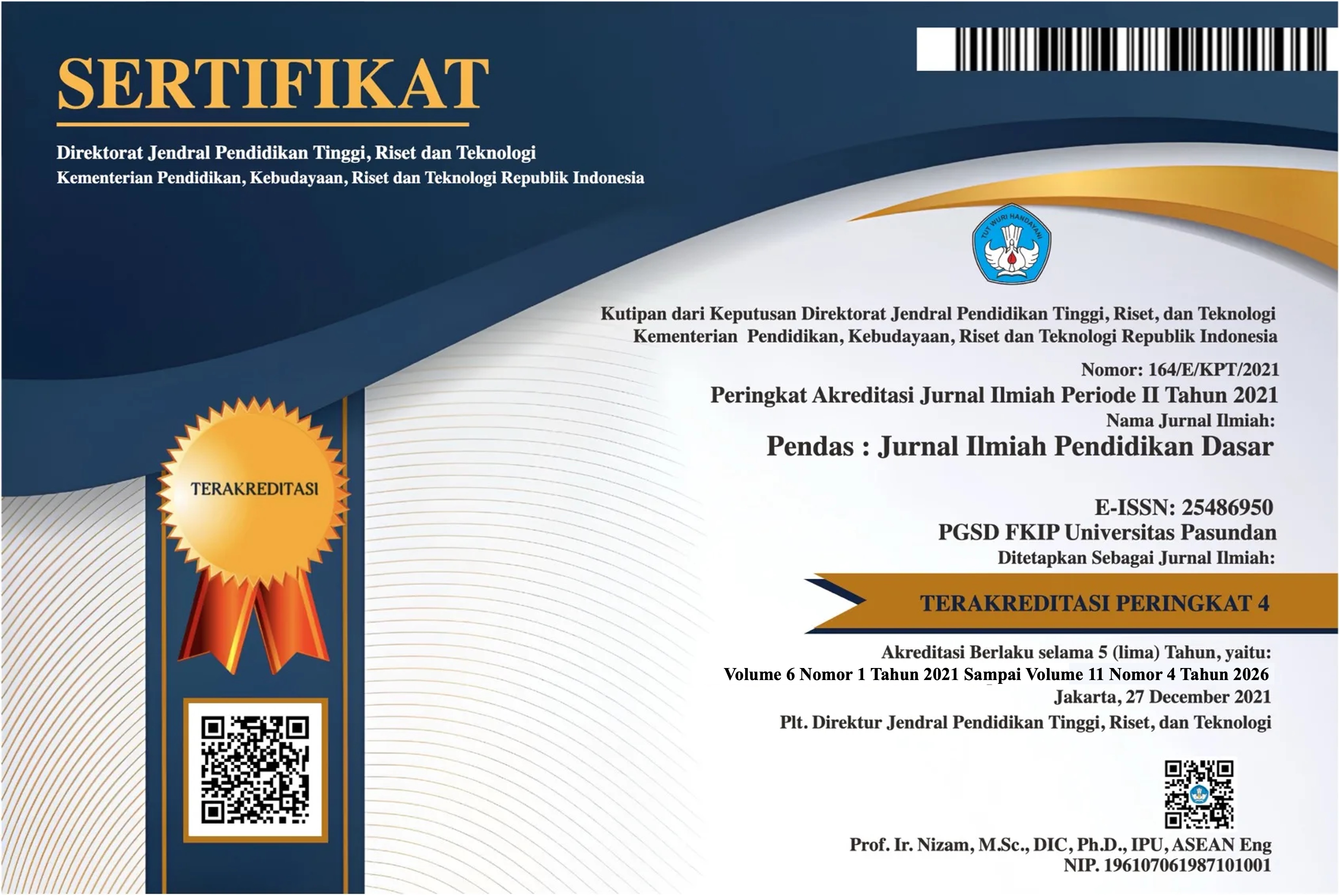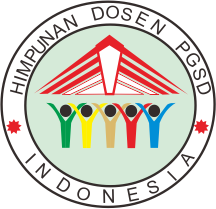MODEL PEMBELAJARAN CENTERS BASED LEARNING UNTUK TINGKATKAN KRITIS DAN KEMANDIRIAN SISWA KELAS 1 SD
DOI:
https://doi.org/10.23969/jp.v9i04.21183Keywords:
Learning model; Center-based Learning; Critical thinking skills; Student independence; Number additionAbstract
The implementation of learning models still requires various developments and improvements. Therefore, one of the researcher's efforts to support the teaching and learning process carried out by teachers is to develop effective learning models for improving skills. This study aims to produce a centers-based learning model for the material of adding numbers 1-20 in grade 1 of elementary school to improve critical thinking and independence skills and to test the effectiveness of the learning model through the results of assessing students' skills. The development uses the Research and Development method with the ADDIE approach (Analysis, Design, Develop, Implement, Evaluate). The subjects of this study were grade 1 students (A, B, C) consisting of 63 students from SD Kristen Charis Kota Malang. The results of the study showed that this learning model was effective in improving students' critical thinking and independence skills, as shown by the results of very suitable/suitable validation, and an increase in each category in each aspect improved except for the very low category for critical thinking skills and the not yet visible category for independence aspects.
Downloads
References
Ahmad, et al. (2022). Meningkatkan Kemampuan Matematika Siswa Kelas 1 SD Melalui Bimbingan Operasi Penjumlahan dan Pengurangan Matematik. GHIRAH. 1(2).
Ariadila, S.N., et al. (2023). Analisis Pentingnya Keterampilan Berpikir Kritis Terhadap Pembelajaran Bagi Siswa. Jurnal Ilmiah Wahana Pendidikan. 9(20).
Azizah, M., Siloanto, J., & Cintang, N. (2018). Analisis Keterampilan Berpikir Kritis Sisa Sekolah Dasar pada Pembelajaran Matematika Kurikulum 2013. Jurnal Penelitian Pendidikan. 35(1).
Damayanti, H. L., & Anando, A. A. (2021). Peran Guru Dalam Menumbuhkembangkan Kemandirian Siswa Melalui Pembelajaran Inkuiri. Jurnal Sinestesia, 11(1), 52–59.
Dick, W; Carey, L & Carey, J .O. (2009). The systematic design of instruction,(seventh edition).Upper Saddle River, N.J: Pearson Education, Inc.
Gullo, D. F., & Hughes, K. (2011). Reclaiming kindergarten: Part 1. questions about theory and practice. Early Childhood Education Journal, 38(5), 323-328.
Hamand, D. (2019). The Use of Learning Centers in the Kindergarten Classroom. Master’s Theses & Capstone Projects. Northwestern College.
Harmanto, M. I. (2017). Analisis kesalahan siswa kelas ii sd watesnegoro ii dalam menyelesaikan soal operasi hitung bilangan cacah. Universitas muhammadiyah sidoarjo. 1-6.
Hidayat, F., & Nizar, M. (2021). Model ADDIE (Analysis, Design, Development, Implementation, Evaluation) dalam Pembelajaran Pendidikan Agama Islam. Jurna Inovasi Pendidikan Agama Islam. 1(1).
Hidayaty, A., et al. (2022). The Influence of Word Wall on Students’ Interest and Learning Outcomes. Jurnal Penelitian Ilmu Pendidikan. 15(2). 211-223.
Karim., & Normaya. (2015). Kemampuan Berpikir Kritis Siswa dalam Pembelajaran Matematika dengan Menggunakan Model JUCAMA di Sekolah Menengah Pertama. EDU-MAT Jurnal Pendidikan Matematika. 3(1). 92-104.
Khairunisa, Y. (2021). Pemanfaatan fitur gamifikasi daring maze chase–wordwall sebagai media pembelajaran digital mata kuliah statistika dan probabilitas. MEDIASI, 2(1), 41–47. https://doi.org/10.46961/mediasi.v2i1.254
Khoenrunnisa, P., & Aqwal, P. (2020). Analisis Model-Model Pembelajaran. Fondatia : Jurnal Pendidikan Dasar. 4(10).
Maflikha. (2020). Media Pembelajaran Berhitung Kelas 1 SD. Social, Humanities, and Education Studies (SHEs): Conference Series. 3(3).
Marfuah, S. (2019). Peningkatan Kemampuan Penjumlahan Bilangan dalam Pembelajaran Matematika Menggunakan Media Block Dienes bagi Anak Autis Kelas III di SLB Islam Qothrunnada. Jurnal Widia Ortodidaktika. 8(10).
Mutia. (2021). Characteristics of Children Age of Basic Education. FITRAH. 3(1). E-ISSN 2722-7294.
Nurillahwaty, E. (2022). Peran Teknologi dalam Dunia Pendidikan. Prosiding seminar nasional pendidikan. Volume 1.P-ISSN 2985-587X
Oviliani, T.M., & Susanto, R. (2023). The Effect of Wordwall Educational Game-Based Learning Media on Interest in Learning Natural Science. Education and Social Sciences Riview. 4(1). 27-33.
Purnamasari, S., Rahmanita, F., Soffiatun, S., Kurniawan, W., & Afriliani, F. (2022). Bermain Bersama Pengetahuan Peserta Didik Melalui Media Pembelajaran Berbasis Game Online Word Wall. Jurnal Pengabdian Kepada Masyarakat, 3(1), 70–77.
Pyle, A, & Danniels, E. (2017a). A continuum of play-based learning: The role of the teacher in play-based pedagogy and the fear of hijacking play. Early Education and Development, 28(3), 274-289.
Sabrina, R., Fauzi, F., & Yamin, M. Y. M. (2017). Faktor-Faktor Penyebab Rendahnya Motivasi Belajar Siswa dalam Proses Pembelajaran Matematika di Kelas V Sd Negeri Garot Geuceu Aceh Besar. Jurnal Ilmiah Mahasiswa Pendidikan Guru Sekolah Dasar, 2(4),110-118.
Sa’diyah, R. (2017). Pentingnya Melatih Kemandirian Anak. KORDINAT. 16(1).
Rahardian, A. (2022). Kajian Kemampuan Berpikir Kritis (Critical Thinking Skills) dari Sudut Pandang Filsafat. Jurnal Filsafat Indonesia. 5(2).
Sartika, R. (2017). Implementing word wall strategy in teaching writing descriptive text for junior high school students. Journal of English and Education, 5(2).
Septianti, N, & Afiani, R. (2020). Pentingnya Memahami Karakteristik Siswa Sekolah Dasar di SDN Cikokol 2. As-Sabiqun : Jurnal Pendidikan Islam Anak Usia Dini. 2(1). 7-17.
Susanti, E., et al. (2019). Kemampuan Berpikir Kritis Siswa SDN Margorejo VI Surabaya Melalui Model Jigsaw. Bioedusiana. 4(1).
The National Association for the Education of Young Children. (1995). From basics of developmentally appropriate practice: An introduction for teachers of kindergarteners. Retrieved from http://docplayer.net/30033724-Learning-center-goals-observation-andassessment.htm
Utami, N. A., & Humaidi. (2019). Analisis Kemampuan Penjumlahan dan Pengurangan Bilangan pada Siswa SD. Jurnal Elementary; Kajian Teori dan Hasil Penelitian Pendidikan Sekolah Dasar. 2(2). 39-43.
Widyastuti, E., & Susiana. (2018). Using the ADDIE model to develop learning material for actuarial mathematics. The Sixth Seminar Nasional Pendidikan Matematika Universitas Ahmad Dahlan 2018. doi:10.1088/1742-6596/1188/1/012052.
Zulvira, R. et al. (2021). Karakteristik Siswa Kelas Rendah Sekolah Dasar. Jurnal Pendidikan Tambusai. 5(1). 1846-1851.
Downloads
Published
Issue
Section
License
Copyright (c) 2025 Pendas : Jurnal Ilmiah Pendidikan Dasar

This work is licensed under a Creative Commons Attribution 4.0 International License.



















